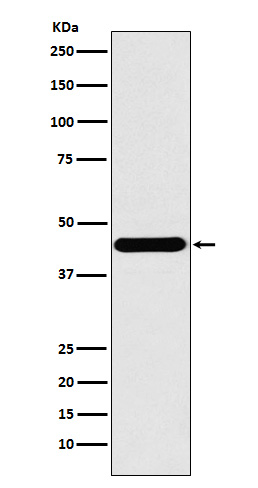Anti-ILF2 Rabbit Monoclonal Antibody
- SPECIFICATION
- CITATIONS
- PROTOCOLS
- BACKGROUND

Application
| WB, IHC, IP, FC |
|---|---|
| Primary Accession | Q12905 |
| Host | Rabbit |
| Isotype | IgG |
| Reactivity | Rat, Human, Mouse |
| Clonality | Monoclonal |
| Format | Liquid |
| Description | Anti-ILF2 Rabbit Monoclonal Antibody . Tested in WB, IHC, IP, Flow Cytometry applications. This antibody reacts with Human, Mouse, Rat. |
| Gene ID | 3608 |
|---|---|
| Other Names | Interleukin enhancer-binding factor 2, Nuclear factor of activated T-cells 45 kDa, ILF2, NF45 |
| Calculated MW | 43062 Da |
| Application Details | WB 1:500-1:2000 IHC 1:50-1:200 IP 1:50 FC 1:100 |
| Contents | Rabbit IgG in phosphate buffered saline, pH 7.4, 150mM NaCl, 0.02% sodium azide and 50% glycerol, 0.4-0.5mg/ml BSA. |
| Clone Names | Clone: 18I48 |
| Immunogen | A synthesized peptide derived from human ILF2 |
| Purification | Affinity-chromatography |
| Storage | Store at -20°C for one year. For short term storage and frequent use, store at 4°C for up to one month. Avoid repeated freeze-thaw cycles. |
| Name | ILF2 |
|---|---|
| Synonyms | NF45 |
| Function | Chromatin-interacting protein that forms a stable heterodimer with interleukin enhancer-binding factor 3/ILF3 and plays a role in several biological processes including transcription, innate immunity or cell growth (PubMed:18458058, PubMed:31212927). Essential for the efficient reshuttling of ILF3 (isoform 1 and isoform 2) into the nucleus. Together with ILF3, forms an RNA-binding complex that is required for mitotic progression and cytokinesis by regulating the expression of a cluster of mitotic genes. Mechanistically, competes with STAU1/STAU2-mediated mRNA decay (PubMed:32433969). Also plays a role in the inhibition of various viruses including Japanese encephalitis virus or enterovirus 71. |
| Cellular Location | Nucleus, nucleolus. Cytoplasm. Nucleus. Note=Localized in cytoplasmic mRNP granules containing untranslated mRNAs |

Thousands of laboratories across the world have published research that depended on the performance of antibodies from Abcepta to advance their research. Check out links to articles that cite our products in major peer-reviewed journals, organized by research category.
info@abcepta.com, and receive a free "I Love Antibodies" mug.
Provided below are standard protocols that you may find useful for product applications.
If you have used an Abcepta product and would like to share how it has performed, please click on the "Submit Review" button and provide the requested information. Our staff will examine and post your review and contact you if needed.
If you have any additional inquiries please email technical services at tech@abcepta.com.













 Foundational characteristics of cancer include proliferation, angiogenesis, migration, evasion of apoptosis, and cellular immortality. Find key markers for these cellular processes and antibodies to detect them.
Foundational characteristics of cancer include proliferation, angiogenesis, migration, evasion of apoptosis, and cellular immortality. Find key markers for these cellular processes and antibodies to detect them. The SUMOplot™ Analysis Program predicts and scores sumoylation sites in your protein. SUMOylation is a post-translational modification involved in various cellular processes, such as nuclear-cytosolic transport, transcriptional regulation, apoptosis, protein stability, response to stress, and progression through the cell cycle.
The SUMOplot™ Analysis Program predicts and scores sumoylation sites in your protein. SUMOylation is a post-translational modification involved in various cellular processes, such as nuclear-cytosolic transport, transcriptional regulation, apoptosis, protein stability, response to stress, and progression through the cell cycle. The Autophagy Receptor Motif Plotter predicts and scores autophagy receptor binding sites in your protein. Identifying proteins connected to this pathway is critical to understanding the role of autophagy in physiological as well as pathological processes such as development, differentiation, neurodegenerative diseases, stress, infection, and cancer.
The Autophagy Receptor Motif Plotter predicts and scores autophagy receptor binding sites in your protein. Identifying proteins connected to this pathway is critical to understanding the role of autophagy in physiological as well as pathological processes such as development, differentiation, neurodegenerative diseases, stress, infection, and cancer.


